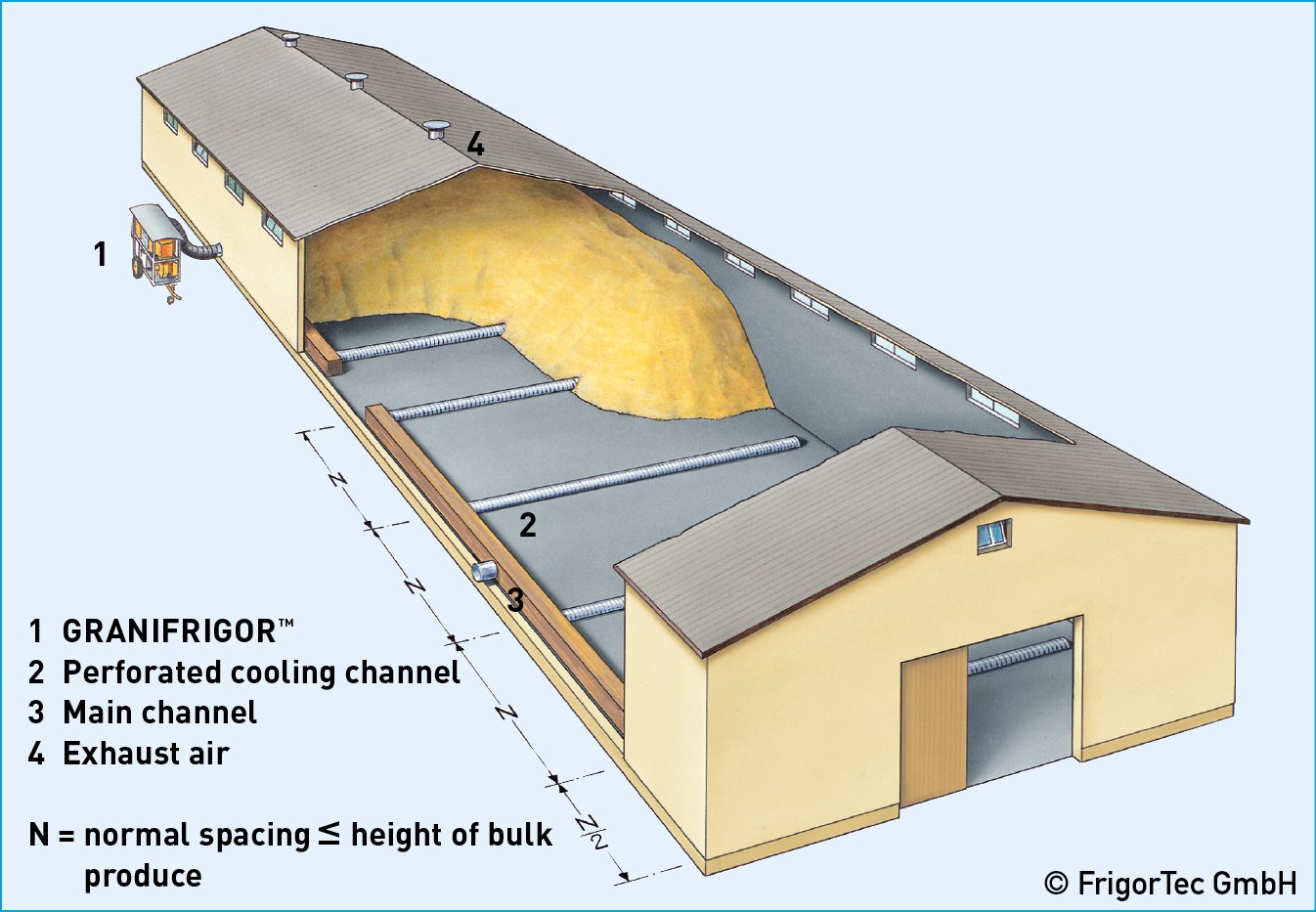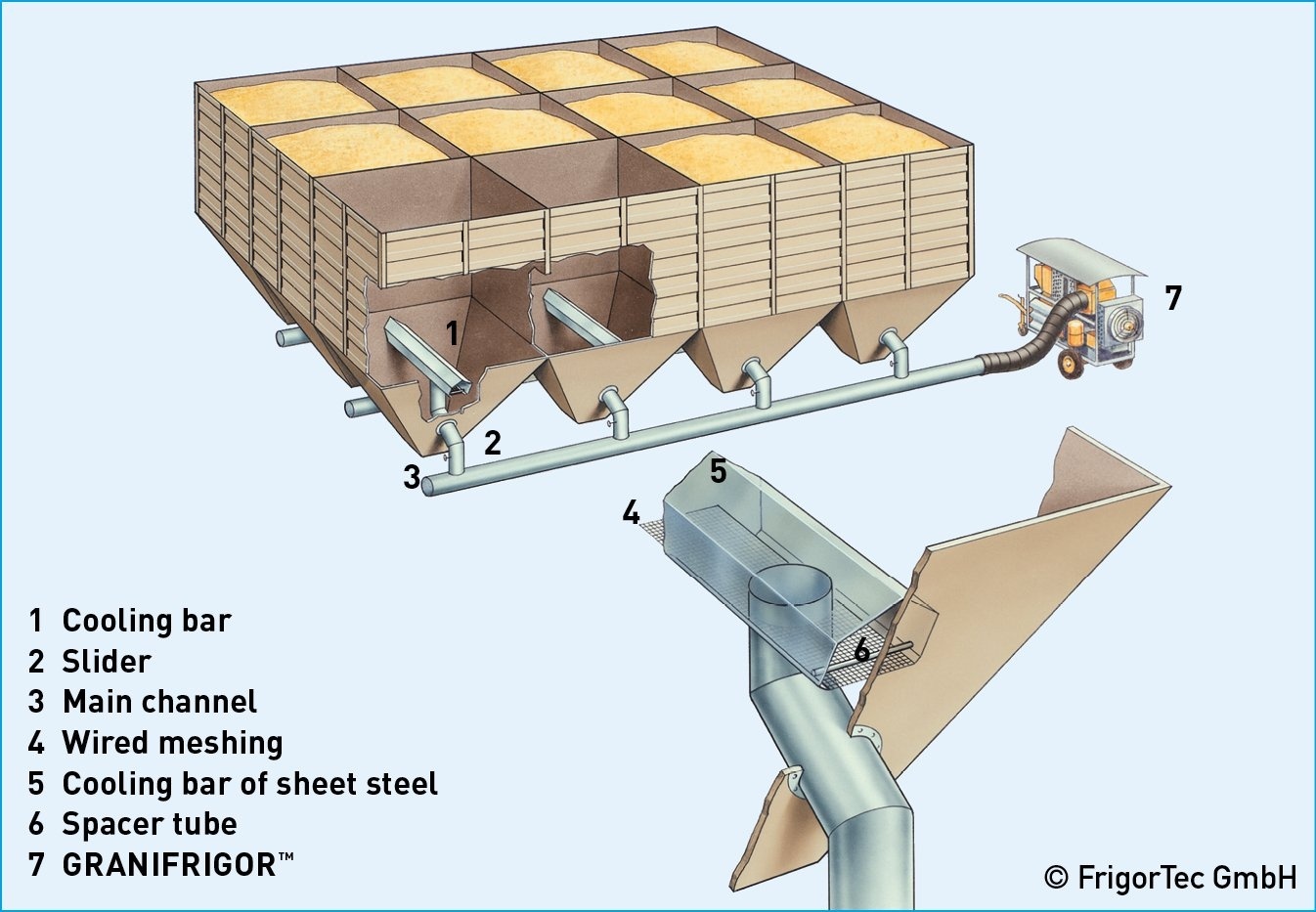The best cooling strategy for your grain storage method
Grain can be cold-stored in both floor-level stores and silos. However cooling of the loose grain requires professional air distribution. The grain cooler must also be selected according to requirements. The fully automated control then frees up time for other activities.
Level spreading of grain in floor-level stores is advantageous
In many floor-level stores, perforated steel sheets with half-shell sections serve as cooling channels on the floor. If the accessibility to the warehouse is a priority, for example for storing and retrieving the grain, it is advisable to install the cooling system under the floor. The cooling channels embedded in the floor are covered with perforated metal sheets. The distance between the channels should not be greater than the height of the bed, and the distance between the channels and the end walls should accordingly be only half as large.
The cooling channels either go from a collecting channel within the floor level store or exit separately from the grain store. In any case, the air ducts should be as short as possible so that the air precisely conditioned by the grain cooler is not heated up. Friction and solar radiation can lead to heating of around 1 °C per 3 m hose length. Conical dumps should be levelled for storage. If this was not done the cold air would not flow through the grain as the air takes the path of least resistance through the grain. The conical piles can be compensated for by differential hole arrays in the air channels or the selective covering of individual areas of the loose grain.

Principle air distribution in a floor-level store
Silos generate high counterpressures
In a silo with a flat base, the cold air can be pushed evenly into the grain over the entire cross-section via a perforated floor. If the silo is emptied via an outlet cone, the air can be distributed via a discharge hopper (shown in the figure below as an example on a honeycomb silo system). The cooling strip made of folded steel sheet is supplied with cold air via a pipe and conveys it into the grain via its open underside. In this case, due to the resistance of the grain, the air is distributed evenly over the cross-section of the bed. Sufficient openings are required below the silo roof to release the exhaust air into the environment. In autumn, condensation can form in the area of the silo roof. This is remedied by the insulation of the silo roof or a suction fan that can deliver large amounts of air at low pressure.

Cooling strip configuration in a honeycomb silo system
The pressure loss (also counterpressure) of the air, which increases with every metre of altitude, is particularly challenging with grain cooling in standard silos and tower silos. The silo or bulk height is therefore a decisive factor when choosing a grain cooling device. A grain cooler with a fan that is not powerful enough does not generate enough pressure to create a reliable flow through a silo with large conical pile heights. In the case of tall silo cells with a small cross-section, the pressure loss can be between 4,000 and 6,000 Pa. For comparison, in a floor-level store with a conical pile height of less than 10 m, the counterpressure is usually less than 1,000 Pa. In tall, very "thin" silos, the counterpressure can be reduced by connecting several cells in parallel.
The pressure loss also depends on the aerodynamics of the stored grain: due to smaller, closely spaced grains, rapeseed generates a counterpressure three to five times higher than that of wheat. The warming of the cold air due to air friction within the grain must also be taken into account when setting the cooling values. Tall, thin silos can heat up to 0.5 - 4 °C. For effective heat transfer from grain to air, the temperature difference at the top of the grain bed should be at least 2 °C. When this difference is reached, the cooling unit can be switched off
Our products
More know-how articles
How you protect your grain from fungi and pests
The infestation of the grain with pests and the development of secondary fungi must be prevented. It is therefore all the more important to create suboptimal conditions for insect pests and moulds during storage, thereby reducing the risk of spoiling of the grain to a minimum.
Commissioning and maintenance of grain cooling devices
With the new fully automated controller from FrigorTec, the grain cooling unit operates fully automatically. In addition to correct commissioning and settings, careful maintenance is essential for the best possible cooling performance. We describe these and other aspects clearly in our videos.
Combining grain coolers for a flexible solution
Operators of a grain storage facility with a capacity of 76.000 tonnes are looking for a cooling solution that works independently from the weather. A combination of one permanently installed central GRANIFRIGOR™ cooler and two mobile units proves to be a flexible solution that meets all requirements.
Safe storage conditions no matter the weather
A storage facility from the 1970s was designed for ambient ventilation. The switch to a GRANIFRIGOR™ KK 280 AHY allows for precise cooling in all weather conditions. The new cooling solution also eliminates silo condensation problems and prolongs the storage duration of malting barley.
Arrange a consultation appointment
Our experts will be happy to advise you on the planning and implementation of your projects. Together we will find a perfect customised solution.
Arrange an appointment